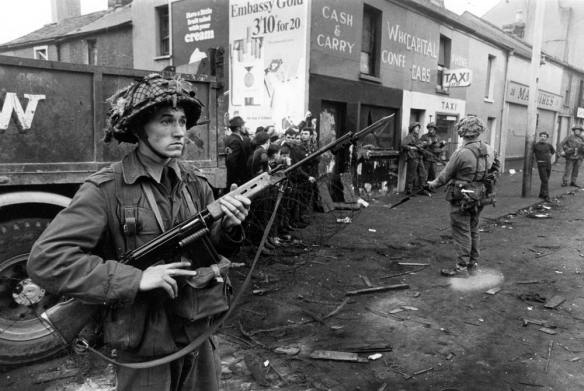
An unexpected revival in the commitment to home defense was seen not in the shape of the defense of Britain from invasion, the key issue in 1940, but rather that of dealing with sustained civil unrest in Northern Ireland. Much of the army served there from 1969, and, in terms of manpower and training, Northern Ireland became a major commitment. This underlined the variety of military tasks. In place of the focus on state-to-state conflict with regulars, seen in the North Atlantic Treaty Organization (NATO) training, came the support for the civil power that had proved so important in the defense of the empire. Indeed, the dispatch of reinforcements to Northern Ireland in 1969 followed swiftly on the heels of the withdrawal of forces from the colony of Aden in 1967 after the failure to suppress insurrection there. The need to succeed was more apparent in Northern Ireland, where rioting had broken out in 1968, and the context of domestic political and public scrutiny was much more trying for both military and government. The deployment was intended as a short-term measure, but, instead, the very presence of troops became an issue and led to violence. In 1971, the Provisional Irish Republican Army (IRA), a Catholic nationalist terrorist organization, launched its first major offensive and, amid widespread shooting and bombings the following year, the Catholic population and the army increasingly saw each other as enemies. Despite the difficulties of the situation, the army, which increased its strength in Northern Ireland from 6,000 troops in 1969 to 20,000 in 1972, succeeded, in Operation Motorman, in ending the “no-go” areas in Belfast and Londonderry that the Provisional IRA had created as a standard stage in the Maoist theory of revolutionary warfare. Instead, the Provisional IRA turned to terrorism.
Confronting this proved a more arduous challenge, with the army having to maintain a semblance of order sufficient to demonstrate to the Catholic Nationalist terrorists of the Provisional IRA that they could not win, and also to encourage intransigent Catholic and Protestant politicians eventually to talk with each other. This proved a very long-term commitment, which was accentuated when Protestant “Loyalist” terrorists began armed action against Catholics, providing a new opponent of the army, Northern Ireland placed a major strain on manpower and morale. IRA terrorism made it difficult for the army to fraternize with the population, and ambushes ensured that garrisons had to be supplied and reinforced by helicopters. Furthermore, the IRA found shelter in the Republic of Ireland and it proved impossible to control the border. Nevertheless, the infantry, who bore most of the commitment, proved resilient, training adjusted to the particular challenges of the task, and the army acquired considerable experience in antiterrorist policing. Instead of tanks or bombing, military proficiency was measured in traditional infantry skills, such as patrolling and the use of cover. However, the difficulty of ending terrorism in the absence of widespread civilian support became readily apparent. Policy would probably have been different had there been a conscript army. Conscripts might have been unwilling to serve in Northern Ireland, and the deployment and tactics employed might have placed a greater emphasis on avoiding casualties.
#
The formal introduction of the Special Air Service (SAS) to Northern Ireland in early 1976 – when Mason had been Defence Secretary – served as a deterrent, which is why Prime Minister Wilson took the unprecedented step of announcing its deployment in public. According to Rees, it was `more presentational and mystique-making than anything else’, and the fact that the SAS – with its reputation for ruthlessness and bravery – was soon blamed for every suspicious incident in the province seemed to confirm its value in that regard. Still, the deterrent effect clearly backfired when it turned out that some SAS units were involved in a series of controversial ambushes which involved the accidental – and ultimately avoidable – killing of civilians. Whilst it is not possible to examine every alleged `shoot-to-kill’ incident in detail, it is worth pointing out that the SAS also carried out many arrests, even in circumstances when `silencing the suspect’ could have spared the troops considerable embarrassment. The idea of assassination squads is at odds with the strategic tradition of the British government generally, and it contradicts almost every tactical consideration of the security forces at the time, such as the near obsession with achieving convictions in court and the emphasis on turning arrestees into informers. Nonetheless, by scaling down its frontline role from 1978, the government conceded that the SAS was a military tool that was too imprecise to perform in an environment where the security forces were expected to adhere to the principle of minimum force at all times.